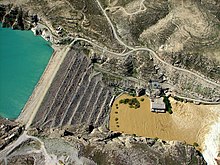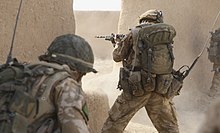
A paratrooper is a military parachutist—someone trained to parachute into a military operation, and usually functioning as part of airborne forces. Military parachutists (troops) and parachutes were first used on a large scale during World War II for troop distribution and transportation. Paratroopers are often used in surprise attacks, to seize strategic objectives such as airfields or bridges.

The 101st Airborne Division (Air Assault) ("Screaming Eagles") is a light infantry division of the United States Army that specializes in air assault operations. It can plan, coordinate, and execute multiple battalion-size air assault operations to seize terrain. These operations can be conducted by mobile teams covering large distances, fighting behind enemy lines, and working in austere environments with limited or degraded infrastructure. It was active in, for example, foreign internal defense and counterterrorism operations in Iraq, in Afghanistan in 2015–2016, and in Syria, as part of Operation Inherent Resolve in 2018–2021.

The 82nd Airborne Division is an airborne infantry division of the United States Army specializing in parachute assault operations into hostile areas with a U.S. Department of Defense mandate to be "on-call to fight any time, anywhere" at "the knife's edge of technology and readiness." Primarily based at Fort Liberty, North Carolina, the 82nd Airborne Division is part of the XVIII Airborne Corps. The 82nd Airborne Division is the U.S. Army's most strategically mobile division.
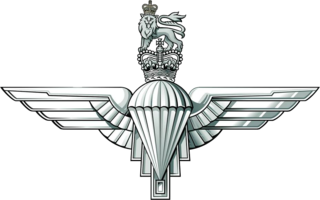
The Parachute Regiment, colloquially known as the Paras, is the airborne and infantry regiment of the British Army. The first battalion is part of the Special Forces Support Group under the operational command of the Director Special Forces. The other battalions are the parachute infantry component of the British Army's rapid response formation, 16 Air Assault Brigade. The Paras, along with the Guards, are the only line infantry regiment of the British Army that has not been amalgamated with another unit since the end of the Second World War.
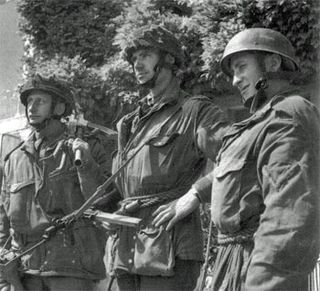
The 6th Airborne Division was an airborne infantry division of the British Army during the Second World War. Despite its name, the 6th was actually the second of two airborne divisions raised by the British Army during the war, the other being the 1st Airborne Division. The 6th Airborne Division was formed in the Second World War, in mid-1943, and was commanded by Major-General Richard N. Gale. The division consisted of the 3rd and 5th Parachute Brigades along with the 6th Airlanding Brigade and supporting units.

In military organizations, a pathfinder is a specialized soldier inserted or dropped into place in order to set up and operate drop zones, pickup zones, and helicopter landing sites for airborne operations, air resupply operations, or other air operations in support of the ground unit commander. Pathfinders first appeared in World War II, and continue to serve an important role in today's modern armed forces, providing commanders with the option of flexibly employing air assets. There was a group of pilots who were also designated pathfinders. They flew C-47 (DC-3) aircraft and were the lead planes followed by paratroop transports, used for dropping paratroopers into designate drop zones such as on D day, the Normandy Invasion.

16 Air Assault Brigade Combat Team, known simply as 16 Air Assault Brigade from 1999 – 2021, is a formation of the British Army predominantly based in Colchester, Essex. It makes up the Air Assault Task Force, a battlegroup held at high readiness, and is the only brigade in the British Army focused on operating via parachute, helicopter and air-landing.
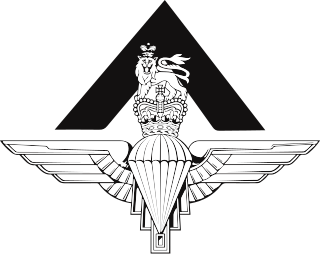
The Pathfinder Platoon is a pathfinder unit of the British Army, and an integral part of 16 Air Assault Brigade. The Pathfinder Platoon acts as the brigade's advance force and reconnaissance force. Its role includes locating and marking drop zones and helicopter landing zones for air landing operations. Once the main force has landed, the platoon provides tactical intelligence and offensive action roles for the brigade.
The British Army primarily divides its infantry into regiments, which are subdivided into battalions. However, for various reasons, since the end of the Second World War it has also maintained companies that are intended to provide increments and reinforcements.

The 505th Parachute Infantry Regiment, originally the 505th Infantry Regiment, is an airborne infantry regiment of the United States Army, one of four infantry regiments of the 82nd Airborne Division of the United States Army, with a long and distinguished history.

The 3rd Parachute Brigade was an airborne forces brigade raised by the British Army during the Second World War. The brigade was initially part of the 1st Airborne Division, but remained in Britain when that division was sent overseas, and became part of the 6th Airborne Division, alongside 5th Parachute Brigade and 6th Airlanding Brigade.

The 4th Battalion, Parachute Regiment, is an Army Reserve unit of the British Army. Now recruiting across the United Kingdom originally the Battalion covered the North of England, with its headquarters located in Pudsey, West Yorkshire. Following the Options for Change review in 1993, 4 PARA amalgamated with the 15th (Scottish) Battalion of the Parachute Regiment, which was downsized and became 15 (Scottish) Company of 4 PARA. As part of further changes in 1999, the Battalion also merged with the 10th (Volunteer) Battalion which then became 10 (London) Company.
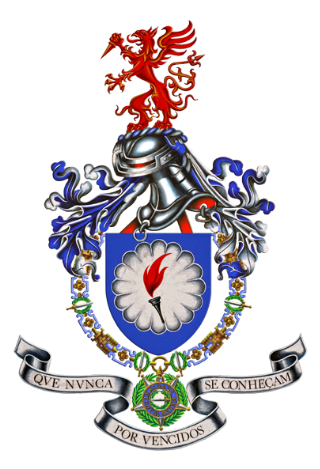
The Regimento de Paraquedistas, based in Tancos, Portugal, is a unit of the Portuguese Army and serves as the instruction center for recruitment and training of the Portuguese paratroopers. This unit includes an entire battalion, acting as support and reserve for airborne units which contains for example, military war dogs and airborne pathfinders and an instruction battalion responsible for the forming of new paratroopers.

The 1st Battalion, Parachute Regiment, is a battalion of the British Army's Parachute Regiment. Along with various other regiments and corps from across the British Armed Forces, it is part of Special Forces Support Group.

The Second Battalion, Parachute Regiment, is a formation of the Parachute Regiment, part of the British Army, and subordinate unit within 16th Air Assault Brigade.

The 7th Parachute Battalion was an airborne infantry battalion of the Parachute Regiment, formed by the British Army during the Second World War. The battalion was raised in November 1942 by the conversion of the 10th Battalion, Somerset Light Infantry to parachute duties. It was initially assigned to the 3rd Parachute Brigade, part of 1st Airborne Division, but moved to the 5th Parachute Brigade, alongside the 12th and 13th Parachute battalions, of the 6th Airborne Division soon afterwards.

The 8th (Midlands) Parachute Battalion was an airborne infantry battalion of the Parachute Regiment, raised by the British Army during the Second World War. The battalion was created in late 1942 by the conversion of the 13th Battalion, Royal Warwickshire Regiment to parachute duties. The battalion was assigned to the 3rd Parachute Brigade, serving alongside the 7th and 9th Parachute battalions, in the 1st Airborne Division before being reassigned to help form the 6th Airborne Division in May 1943.

The 9th Parachute Battalion was an airborne infantry battalion of the Parachute Regiment, raised by the British Army during the Second World War. The battalion was created in late 1942 by the conversion of the 10th Battalion, Essex Regiment to parachute duties. The battalion was assigned to the 3rd Parachute Brigade, alongside the 7th and 8th Parachute battalions, then part of the 1st Airborne Division but was later transferred to the 6th Airborne Division.

The 5th (Scottish) Parachute Battalion was an airborne infantry battalion of the Parachute Regiment, raised by the British Army during the Second World War.

The 10th Battalion, The Parachute Regiment was an airborne infantry battalion of the Parachute Regiment, originally raised as the 10th (Sussex) Battalion by the British Army during the Second World War.



